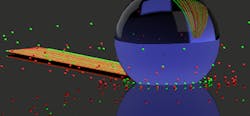Laser-mediated microbubble trap synthesizes metallic nanoalloys
The concept of accumulation-mediated concentration contends that building blocks such as DNA and RNA, hypothesized as central to the emergence of life on earth, formed due to accumulation of precursors within hydrothermal vents, where thermal gradients result in the concentration of prebiotic molecules and vents act as reactors. Now, the Zheng Research Group, Mechanical Engineering Department at The University of Texas at Austin has adapted this phenomena to the nanoscale, utilizing a laser-induced micro bubble trap (MBT) that acts as an accumulator/reactor similar to the hydrothermal vents where supposedly life originated.
The laser-mediated MBT instantaneously accumulates precursor ions, enabling a unified spatiotemporal synthesis and structuring (US3) strategy that combines the conventionally discrete aspects of synthesis and patterning. The US3 strategy achieves all these criteria within milliseconds using a thermoplasmonic gold (Au) nanoisland (AuNI) substrate capable of creating a highly confined thermal gradient in the vicinity of an MBT. In the fabrication concept, a precursor solution consisting of an equimolar mixture of rhodium chloride and gold chloride hydrate is present over the AuNI substrate. Upon the incidence of a low-power (~0.6 mW/mm2) continuous-wave 532 nm laser beam through a high-magnification objective, the AuNIs excited on resonance re-emit the energy via nonradiative Landau damping, which results in intense localized thermal gradients and eventually leads to the formation of MBT.
The researchers applied the accumulation-driven technique toward the synthesis and simultaneous structuring of immiscible nanoalloys, which have been found to exhibit unique and significantly enhanced optical, electrical, and catalytic characteristics, distinct from the pure metals. Like the creation of complex multicomponent biological building blocks, the blending of multiple elements is an attractive strategy to tune the properties of inorganic materials via atomic ordering, size, and composition. As a case in point, the team synthesized and printed rhodium-gold (RhAu) nanoalloys in one shot at the MBT at a temperature of about 120°C. RhAu nanoalloys are challenging systems to synthesize, with these alloys predicted to have no stable regions below about 1850°C and 1.0 atm. The researchers were able to accumulate precursor ions at ultrahigh supersaturation within millisecond timeframes at the MBT, enabling a threefold reduction in synthesis time from seconds/minutes for current protocols toward millisecond timeframes via US3. Reference: B. B. Rajeeva et al., Matter (2019); https://doi.org/10.1016/j.matt.2019.10.017.

John Lewis | Editor in Chief (2018-2021)
John Lewis served as Editor in Chief of Laser Focus World from August 2018 through October 2021, after having served as the Editor in Chief of Vision Systems Design from 2016 to 2018. He has technical, industry, and journalistic qualifications, with more than 13 years of progressive content development experience working at Cognex Corporation. Prior to Cognex where his articles on machine vision were published in dozens of trade journals, he was a technical editor for Design News, covering automation, machine vision, and other engineering topics, for over six years.
